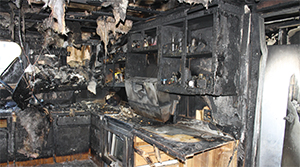The fire that swept through a pushboat docked in the Houston Ship Channel last year likely started in a bathroom exhaust fan, according to the National Transportation Safety Board (NTSB).
Investigators examining the February 2016 incident cited the captain’s “excessive delay in requesting shoreside assistance.” Authorities also identified deficiencies with crew fire drills and mustering practices during emergencies.
The 2,000-hp San Gabriel arrived at LyondellBasell’s Houston terminal at 2100 on Feb. 26. An hour later, a deck hand noticed a fire in the engine room’s upper level bathroom. The deck hand told the captain, who sounded the general alarm, waking the other three crewmembers.
The deck hand and captain each emptied their fire extinguishers trying to fight the blaze. By then, the fire had spread into a cabinet where paper products were stored and the extinguishers had little effect. Another crewman tried to use the fire hose but the fire pump would not activate.
“After failing to put out the fire with the extinguishers, the captain locked down the engine room by closing both doors, ordered the crew to vacate the area and activated the engine room’s CO2 fire suppression system, which discharged all seven (100-pound) bottles,” the NTSB report said.
Crew watched the fire through the engine room windows. After 30 minutes, they thought it was extinguished and someone opened an engine room door, allowing the fire to re-ignite. Crew again fought the blaze with fire extinguishers but it continued to grow.
The pushboat captain contacted the terminal’s fire department at about 2330, and firefighters began arriving within about 15 minutes. Teams from the Houston Refinery Fire Department, Houston Fire Department and two Houston Port Authority fireboats fought the fire with foam and water. At 0048 on Feb. 27, fire crews boarded the tug and extinguished the flames within a half-hour.
Fire investigators toured the boat the next morning and found significant damage. Interior spaces on the main deck, quarter deck and wheelhouse deck were charred and some exterior components melted. The engine room lavatory where the fire started “was totally consumed.”
“The probable cause of the fire aboard towing vessel San Gabriel was an electrical anomaly related to the lavatory exhaust fan located directly above combustible materials,” the NTSB said in its accident report.
The 8-inch fan, installed by an electrician in 2014, was a Broan model 509. The device was not meant to be left on for extended periods, although the crew said there were times that occurred. A Broan representative did not respond to a request for comment.
Investigators suggested the captain’s delay in calling for assistance contributed to the estimated $875,000 in damage to San Gabriel. The 75-foot pushboat, owned by Houston-based Buffalo Marine Service, was built in 1990.
“Although there was no guidance for a fire in port, the captain did not contact any shoreside assistance for over an hour after the fire was reported to him, and not until the crew had depleted all of the vessel’s firefighting capabilities,” the report said.
“Shoreside firefighters with proper firefighting equipment would have been able to provide guidance on re-entering the engine room space and would have been in position to assist if the fire re-flashed,” it continued.
Buffalo Marine is part of the American Waterways Operators’ Responsible Carrier Program. The company completed the required vessel audits 18 months before the fire, the report said. San Gabriel was inspected two other times in the month preceding the fire.
The pushboat company’s policy required fire drills on the first and third Tuesdays of each month, but investigators learned those drills had not been performed for nearly six weeks before the fire.
Crew also seemed confused about the boat’s mustering location. One crewmember mustered on the bow, while the others told investigators they mustered at the stern. “The station bill did not identify a muster location for crewmembers,” the report said.
The fire also exposed issues with San Gabriel’s firefighting capabilities. For instance, none of its fire alarms sounded after the fire started. Its engine room also lacked dampers on 2-by-2-foot ducts, reducing the CO2 fire suppression system’s effectiveness, the report said. Electrical short circuits caused by the fire disabled the fire pump.
Crew also left open at least one door when abandoning the pushboat for a barge, fueling the fire.
It’s not clear if San Gabriel has been repaired. Calls and emails to a Buffalo Marine spokesman were not returned.

